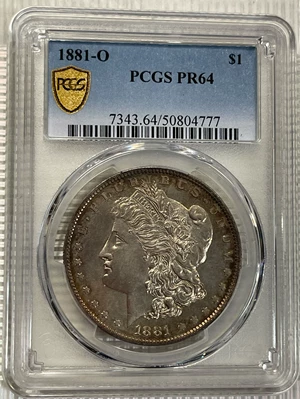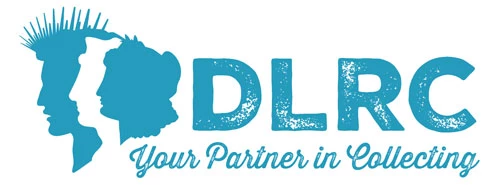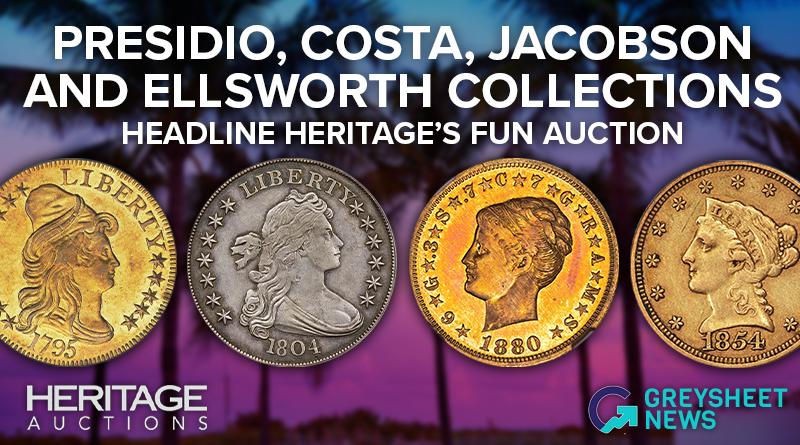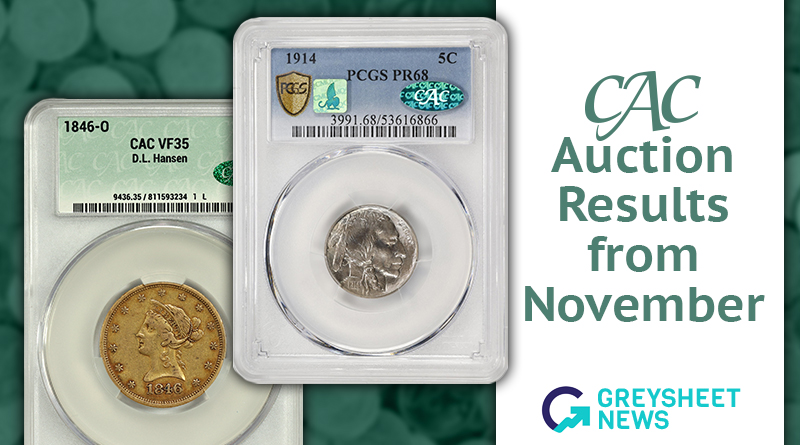- U.S. Coins /
- Dollars /
- Morgan Dollars, Proof (1878–1921) /
- 1881-O $1 PR BM
1881-O $1 PR BM

1881-O Morgan Silver Dollar. Proof-64 (PCGS). CAC. CMQ.
Source: Stacks Bowers

1881-O Morgan Silver Dollar. Proof-64 (PCGS). CAC. CMQ.
Source: Stacks Bowers

1881-O Morgan Silver Dollar. Proof-64 (PCGS). CAC. CMQ.
Source: Stacks Bowers

1881-O $1 Branch Mint Proof PCGS PR64

1881-O Morgan Silver Dollar. Proof-64 (PCGS). CAC. CMQ.
Source: Stacks Bowers

1881-O Morgan Silver Dollar. Proof-64 (PCGS). CAC. CMQ.
Source: Stacks Bowers






Greysheet Catalog Details (GSID: 376657) The 1881-O is an enigmatic issue in this format, one that has kept both the story of its production and the identity of actual specimens well hidden from numismatic scholars. There is, of course, no recorded mintage for this issue, the Mint director's report for the year concerned only with the number of circulation strike 1881-O dollars produced. The earliest known auction appearance for an 1881-O Morgan dollar cataloged as a Proof was in Numismatic Gallery's January 1945 sale of the "World's Greatest Collection" (F.C.C. Boyd). Lot 244 therein was described simply as, "1881. Brilliant Proof. Another rare proof of the New Orleans Mint. Very rare." No price estimate was given. In February 1952, M.H. Bolender's 183rd Auction Sale also featured an 1881-O cataloged as a Proof with a more extensive write-up: [Lot] 252. 1881 New Orleans mint. Perfect brilliant proof. Yes, we realize that proofs were not supposed to have been struck at the branch mints. However, in those days the coiners took pride in their work, and on very rare occasions proof[s] were made, as witness this coin, a gem in every respect. Excessively rare. From the Roe coll'n. at $115. These two auction appearances are referenced in Q. David Bowers' 1993 Silver Dollars & Trade Dollars of the United States: A Complete Encyclopedia. The "World's Greatest Collection" coin realized $50 in 1945, the Jack Roe specimen $67.50 in Bolender's 1952 sale. Predating the Bowers reference by a decade, the earliest mention of the Proof 1881-O Morgan dollar in modern numismatic literature appears to be Wayne Miller's Morgan and Peace Dollar Textbook, published in 1982. On page 213 in that still-indispensable work, the author pictures an alleged Proof 1881-O and describes the coin as: 1881-O: In April of 1982, Kevin Lipton sent me the coin picture above, having just purchased it in an auction the week previously for $3,500. The coin has a partial square rim on both obverse and reverse, and very deep mirror surfaces. The periphery of the coin is toned a light brown. There are several contact marks in the fields and on Liberty's face. The latter shows no sign of being struck from a polished planchet. The strike is not full over Liberty's ear. The reverse is slightly dull, but the strike is very strong. The coin shows some evidence of handling. This makes the attribution of such a piece very difficult. Having seen no other examples with possible claim to this status, and given his enumerated pros and cons for the plated specimen, Miller assigned the 1881-O to his Class III category of branch mint Morgan dollars: "...considered to be possible but doubtful branch mint proofs. These are three coins which might be proofs, specimens of which the author has seen but which do not meet his conservative criteria. The other two coins plated in this category are the 1884-O and 1884-CC. There is no mention of the Proof 1881-O in either Walter Breen's 1988 encyclopedia or his 1989 Proof coin encyclopedia - an unusual omission given that an entire chapter is devoted to branch mint Proof coinage in the latter reference. As above, this enigmatic issue has kept its secrets closely guarded over the years.
Obverse: Portrait of Liberty centered. On the left are found 7 stars with the words E*PLURIBUS*UNUM followed by 6 stars on the right. The date is positioned at the bottom.
Reverse: The heraldic eagle is centered holding a bunch of arrows and branch surrounded by and olive leaves. The words UNITED STATES OF AMERICA * ONE DOLLAR frame the periphery. Mint mark, if any, appears above the letters DO of DOLLAR.
Catalog Detail
Greysheet & CPG® PRICE GUIDE
From the Greysheet Marketplace
Buy Now: $5,087.50
Buy Now: $7,469.38
Auction Ends: 1/5/2026
Buy Now: $8,500.00
Buy Now: $4,250.00
Buy Now: $393.13
Auction Ends: 12/10/2025
Buy Now: $43,359.38
Buy Now: $114.00
Auction Ends: 12/10/2025
Related Stories (powered by Greysheet News)
View all newsAbout CDN Prices
All CDN prices are based on proprietary market knowledge and technology developed by CDN Publishing, LLC.
CPG® prices represent retail levels. Collectors should refer to CPG values as a starting place for their negotiations, or auction bid reference.
Greysheet/Greensheet prices are wholesale market levels for collectible coins/paper money intended to indicate what a dealer, or wholesale, buyer would pay for the described item in the specified grade. Greysheet/Greensheet represent "sight-seen" values based on a buyer's in-hand review. The actual value can be more or less than this depending on factors including eye appeal and market timing.
Bluesheet (NGC & PCGS) prices represent the highest sight-unseen offers to buy on dealer networks like CDN Exchange. In many cases, there are no active sight-unseen buy offers, so CDN looks to the recent lowest market values for such an item. For this reason, Bluesheet values typically represent the floor of the market for the specified item. CDN only tracks Bluesheet on certain items.
CAC prices are for U.S. coins that meet the standards of the Certified Acceptance Corporation. You can learn more about CAC on their web site.
Price movement is indicated for price changes in the last 30 days.
The prices listed in our database are intended to be used as an indication only. Users are strongly encouraged to seek multiple sources of pricing before making a final determination of value. CDN Publishing is not responsible for typographical or database-related errors. Your use of this site indicates full acceptance of these terms.


 Dealers Only
Dealers Only

















